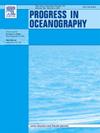2000-2020年海洋混合层深度:估算、评估和长期趋势
IF 3.6
3区 地球科学
Q1 OCEANOGRAPHY
引用次数: 0
摘要
准确估计混合层深度对于理解上层海洋动力学及其对气候和海洋生态系统的影响至关重要。虽然已经提出了各种方法来从垂直温度和/或密度剖面估计MLD,但仍然没有对不同算法进行系统评估。本文基于2000 - 2020年Argo剖面,对12种MLD估算方法进行了比较。每种方法都是根据质量指数(QI)来评估的,QI测量了估计的MLD边界内温度或密度分布的均匀性。我们发现线性拟合和相对方差的两种方法表现出相似的QI水平高于其他方法。然后设计并应用一个排序方案,即给定配置文件中具有最高QI的方法获得一个分数。线性拟合的结果最高,因此被推荐为最可靠的地球物理分析方法。使用这种方法得到的全球MLD模式进行了分析,由于强烈的季节变化,极端情况主要出现在中纬度地区。观测到显著的长期变化,特别是在南半球夏季,那里的MLD在过去20年中显示出加深的趋势。本文提出的结果将为选择最可靠的MLD估计方法和理解MLD变化的环境驱动因素提供有价值的见解。本文章由计算机程序翻译,如有差异,请以英文原文为准。
Ocean mixed layer depth 2000–2020: Estimation assessment and long-term trends
Accurate estimation of mixed layer depth (MLD) is crucial for understanding the upper ocean dynamics as well as their implications on climate and marine ecosystems. While various methods have been proposed to estimate MLD from vertical temperature and/or density profiles, a systematic evaluation across different algorithms remains untapped. In this study, twelve approaches for MLD estimation are implemented and compared based on the Argo profiles collected from 2000 to 2020. Each method is assessed based on the quality index (QI), which measures the uniformity of temperature or density profiles within the boundaries of the estimated MLD. We found the two methods of linear fitting and relative variance exhibit similar QI levels higher than the others. A ranking scheme for that the method with the highest QI for a given profile earns one score is then designed and applied. The linear fitting one obtains the highest and is thus recommended as the most reliable method for geophysical analysis. The global MLD patterns derived using this method are analyzed with extremes being predominantly found in mid-latitudes due to strong seasonal variations. Significant long-term changes are observed, particularly in the southern hemisphere during summer, where the MLD shows a deepening trend over the past 20 years. Results presented here shall provide valuable insights for choosing the most reliable MLD estimation methods and understanding the environmental drivers of MLD variations.
求助全文
通过发布文献求助,成功后即可免费获取论文全文。
去求助
来源期刊

Progress in Oceanography
地学-海洋学
CiteScore
7.20
自引率
4.90%
发文量
138
审稿时长
3 months
期刊介绍:
Progress in Oceanography publishes the longer, more comprehensive papers that most oceanographers feel are necessary, on occasion, to do justice to their work. Contributions are generally either a review of an aspect of oceanography or a treatise on an expanding oceanographic subject. The articles cover the entire spectrum of disciplines within the science of oceanography. Occasionally volumes are devoted to collections of papers and conference proceedings of exceptional interest. Essential reading for all oceanographers.
 求助内容:
求助内容: 应助结果提醒方式:
应助结果提醒方式:


